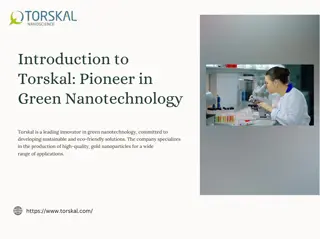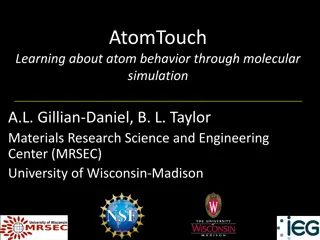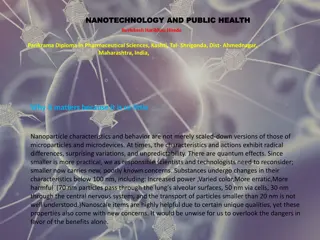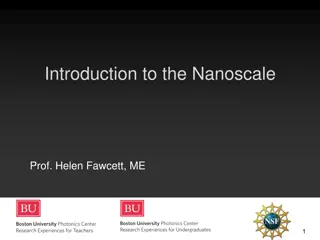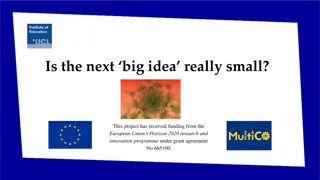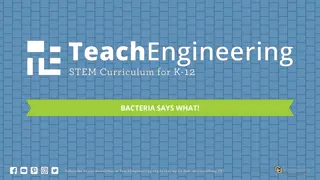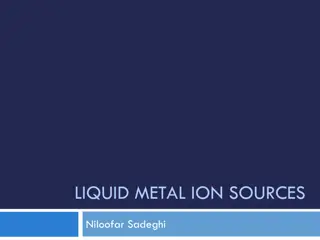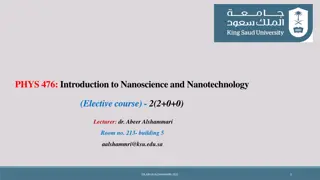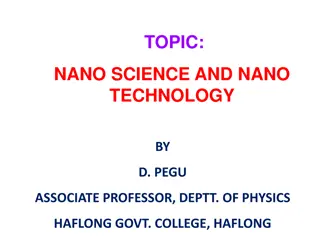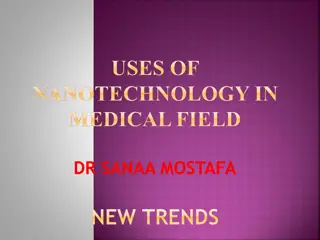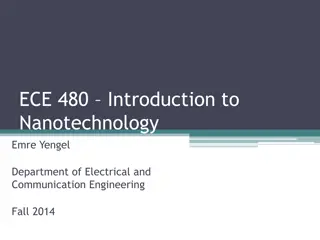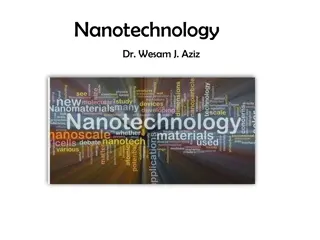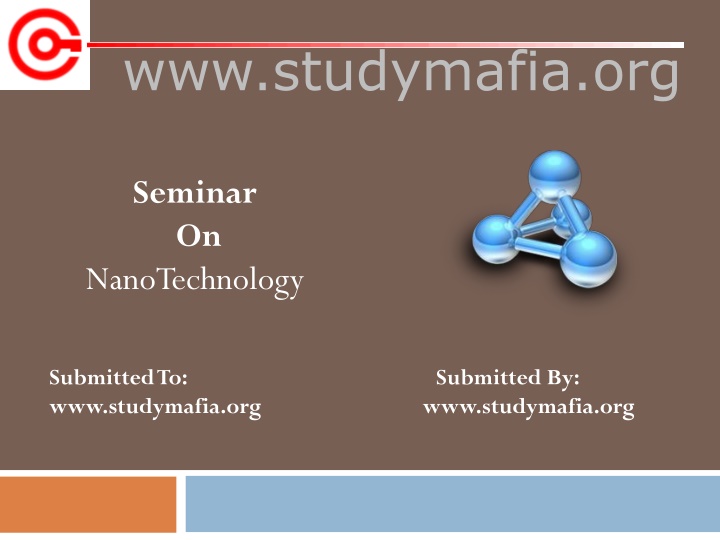
Exploring the Wonders of Nanotechnology
Delve into the world of nanotechnology, where manipulation of matter at the atomic level leads to revolutionary advancements. Discover the origins, definitions, and applications of nanotechnology, and understand why it holds such promise for the future. Explore the nanoscale, learn about nanomaterials, and uncover the unique characteristics that make them so valuable in various industries.
Download Presentation

Please find below an Image/Link to download the presentation.
The content on the website is provided AS IS for your information and personal use only. It may not be sold, licensed, or shared on other websites without obtaining consent from the author. If you encounter any issues during the download, it is possible that the publisher has removed the file from their server.
You are allowed to download the files provided on this website for personal or commercial use, subject to the condition that they are used lawfully. All files are the property of their respective owners.
The content on the website is provided AS IS for your information and personal use only. It may not be sold, licensed, or shared on other websites without obtaining consent from the author.
E N D
Presentation Transcript
www.studymafia.org Seminar On NanoTechnology Submitted To: www.studymafia.org www.studymafia.org Submitted By:
Introduction to Nanotechnology Nanotechnology has enormous potential to change society and it involves manipulation of objects on the automic level. The products will be build on every atom that are stronger, smarter, cheaper, cleaner, and more precise. Nanotechnology is the art and science of manipulating matter at the nanoscale (down to 1/100,000 the width of a human hair) to create new and unique materials and products
Origins of Nanotechnology Noble prize winnerRichard Feynman first conceived the idea of molecular manufacturing in his 1959 speech, There's Plenty of Room at the Bottom." Richard Feynman was the first scientist to suggest that devices and materials could someday be fabricated to atomic specifications In 1986, K. Eric Drexler wrote "Engines of Creation" and introduced the term nanotechnology from there Scientific research really expanded over the last decade
Definition of Nanotechnology Nanotechnology is the understanding and control of matter at dimensions of roughly 1 to 100 nanometers, where unique phenomena enable novel applications. Encompassing nanoscale science, engineering and technology, nanotechnology involves imaging, measuring, modeling, and manipulating matter at this length scale.
How Small Is Nanoscale? A nanometer is one billionth of a meter Human Hair: Approx. 1x105 nm DNA Sample: Approx. 2 nm
Why Nanotechnology? At the nanoscale, the physical, chemical, and biological properties of materials differ in fundamental and valuable ways from the properties of individual atoms and molecules or bulk matter. Nanotechnology R&D is directed toward understanding and creating improved materials, devices, and systems that exploit these new properties.
What is nanomaterial? Is defined as any material that has unique or novel properties, due to the nanoscale ( nano metre- scale) structuring. These are formed by incorporation or structuring of nanoparticles. They are subdivided into nanocrystals, nanopowders, and nanotubes: A sequence of nanoscale of C60 atoms arranged in a long thin cylindrical structure.
Nanomaterials Characteristics Category of nanomaterials example One-dimensional nanomaterials layers, multi-layers, thin films, platelets and surface coatings. They have been developed and used for decades, particularly in the electronics industry. Two-dimensional nanomaterials nanowires, nanofibres made from a variety of elements other than carbon, nanotubes and, a subset of this group, carbon nanotubes. Three-dimensional nanomaterials are known as nanoparticles and include precipitates, colloids and quantum dots (tiny particles of semiconductor materials), and Nanocrystalline materials
Various products in Nanotechnology Below are the list of different products in various sectors Building Products - 45 Automotive - 25 Marine Products - 2 Textile and Fabric - 17 Medical and Health - 31 Nanoparticles - 65 Electronics and Computers- 16 Industrial Products - 75 Cosmetics - 27 Food - 16 Home and Garden - 37 R & D - 7 etc,.
Applications Of Nanotechnology Electronics: Nano Transistors Nano Diodes OLED (Organic Light Emitting Diode)
Applications Of Nanotechnology Electronics(contd.) Plasma Displays Quantum Computers
Applications Of Nanotechnology Energy: Batteries Fuel Cells Solar Cells
Applications Of Nanotechnology Materials: Nano Tubes Aerogel Nano Particles
Future of Nanotechnology Nanotechnology will redesign the future of several technologies, products and markets. Scientists and engineers can now work with materials at the atomic level to create stain-proof fabrics, scratch- resistant paints, more efficient fuel cells and batteries Experts says that nanotechnology will likely create the next generation of billionaires and reshape global business Industry Analysts Predict Revenues from Products Incorporating Nanotechnology to Reach Close to $3 Trillion US Within 10 Years
Govt. policy The Government of India has made Rs. 1000 crore investments in Nanotechnology Karnataka is planning to set up country's first nano park in Bangalore Govt of Andhra Pradesh is planning to set up Nano-technology Park in 350 acre in Hyderabad
Advantages Of Nanotechnology Medical Advantages End of Illnesses (I.e. Cancer, heart disease) Universal immunity (I.e. aids, flu) Body Sculpting (I.e. change your appearance) Stop the aging Process Painless Child births Industrial Advantages Computers a billion times faster and a million times smaller Automatic Pollution Cleanup Manufacturing at almost no cost
Advantages Of Nanotechnology Other advantages Architecture, Engineering and Construction industry Materials Producers Usage Superior Education in Textiles Industries
Disadvantages Of Nanotechnology u Loss of jobs (manufacturing, farming, etc) u Oil Becomes worthless u Diamonds become worthless u Atomic weapons more accessible and destructive
Implications of Nanotechnology Health and safety issues Nanoparticles can cause serious illness or damage human body. Untraceable destructive weapons of mass destruction. Social & Political issues Creates social strife through increasing wealth gap Advisability of increasing scope of the technology creates political dilemma 19
Conclusion Nanotechnology offers the ability to build large numbers of products that are incredibly powerful Nanotechnology is heavily intertwined with biotechnology and information technology, making its scope very wide The nanotechnology industry is mainly used to create new world
References Morph: Nokia s Nanotechnology Concept Phone http://tini.us/morph Wikipedia NT Portal http://wikipedia.com Credits Studymafia.org





